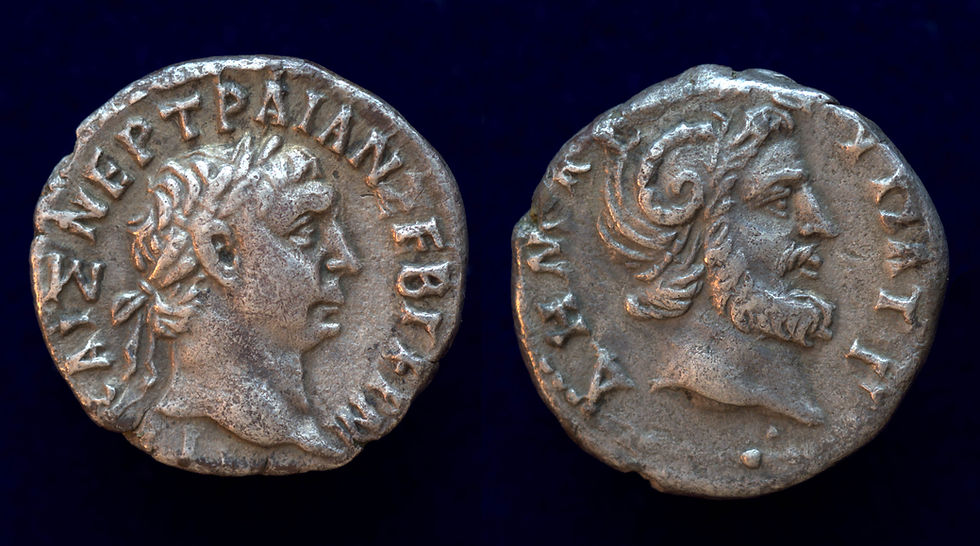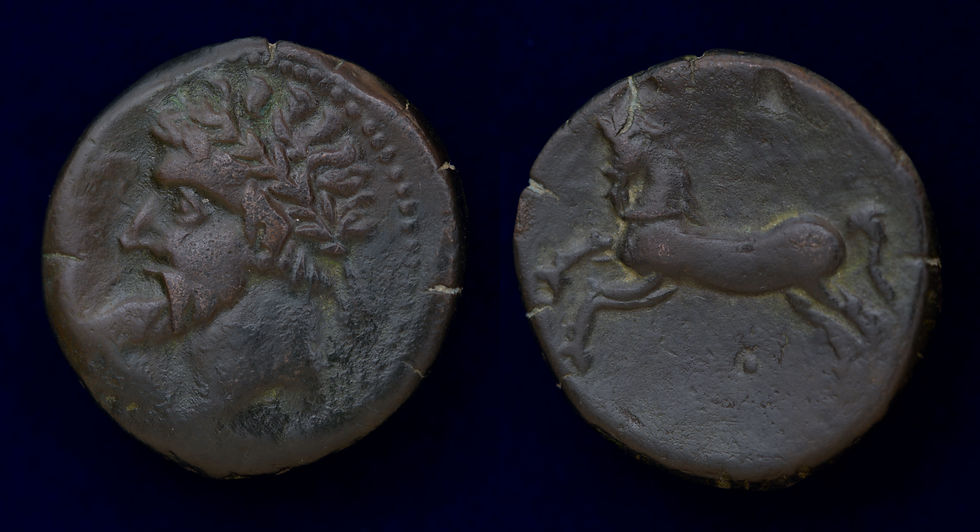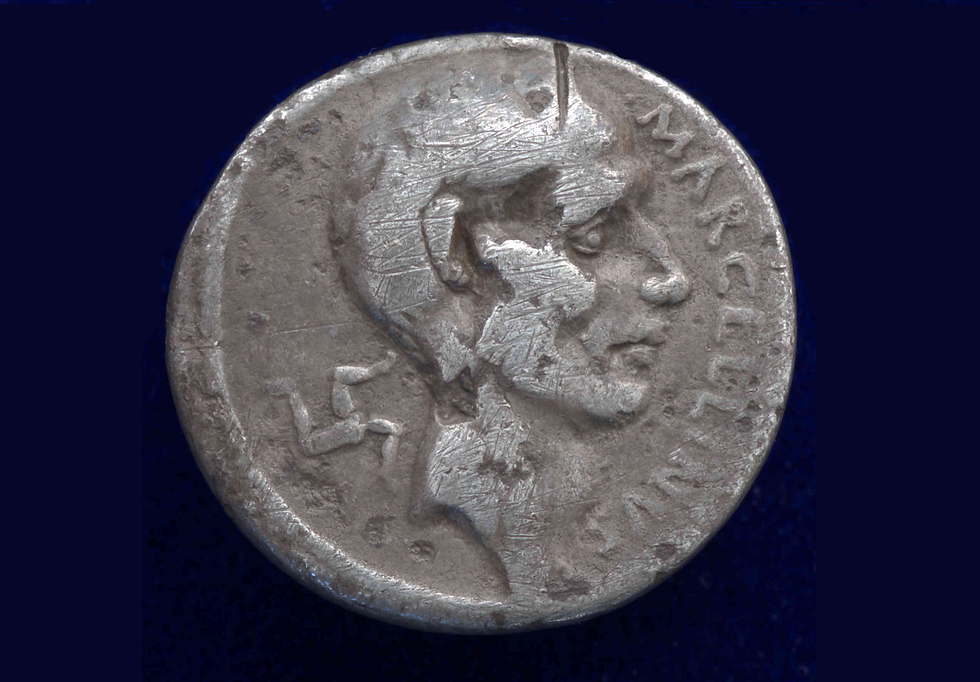Rome & Africa
- sulla80

- Oct 30, 2022
- 9 min read
Updated: Dec 15, 2024
The modern countries, bordering the Mediterranean, west of Egypt, in northern Africa (Algeria, Libya, Mauritania, Morocco and Tunisia) are allied today as the the "Arab Maghreb Union". Maghreb means "West" or more literally "place of setting (of the sun)", derived from ghuroob meaning "to set". The name originated during the spread of Islam to western lands in the 7th Century CE. From the same origin, Al-Maghrib (المغرب) is Morocco's official name.
The northern shores of this area are rich with ancient history and this note will feature coins from this region. Eventually we will come to a coin of Juba I, King of Numidia, supporter of Pompey, The son of Hiempsal II who was the half-brother of Jugurtha. Jugurtha was captured by Sulla for Marius in the Numidian war, This was the start of the rivalry between Marius and Sulla, as Sulla felt he wasn't properly credited for the role he played in the capture of Jugurtha, which delivered the victory and a triumph for Marius.

The Greeks didn't use the term Africa - they called the area Libya. The Romans called a province Africa Proconsularis (roughly Tunisia today). Africa meaning "land of the Afri" (Afri plural, Afer singular). There are multiple hypotheses about the origins of "Afer"
the Afri, possibly a Berber tribe from near Carthage
Phoenician`afar, meaning dust
Greek aphrike, meaning without cold
Latin aprica, meaning sunny
Colonization of Northwest Africa
Beginning around 1000 BC the Phoenicians migrated west to colonize the northern coast of Africa. The great city of Carthage was founded around 800 BC by the Phoenicians fleeing Tyre with Queen Dido, around the same time that the Greeks started to arrive in the western Mediterranean. By the sixth century BC, Carthage had emerged as protector of Phoenician colonists against the Greeks.
A Dividing Line
The Greeks and Phoenician colonists inevitably clashed in the region. Kyrenaica, east of Carthage in modern Libya, was colonized by Greeks in the 7th century. In 510 BC, the Carthaginians expelled the Greeks from Tripolitania, meaning "region of three cities" in reference to Oea (modern Tripoli of Libya), Sabratha and Leptis Magna in what is today western Libya.

Carthage, Second Punic War, Circa 220-215 BC, trishekel (Bronze, 29 mm, 20.32 g, 12 h)
Obv: Head of Tanit to left, wearing wreath of grain ears, pendant earring and simple necklace
Rev: Horse standing right before palm tree
Ref: MAA 84. SNG Copenhagen 344
Note: Punic refers to western Phoenicians
Salust, writing about the Jugurthine War, between Numidia and Rome during the time of Sulla, digresses to tell a story of how the border was formed between Carthage and Kyrenaica.
"After many armies and fleets had been beaten and put to flight on both sides, and the long struggle had somewhat wearied them both, they began to fear that presently a third party might attack victors and vanquished in their weak state. They therefore called a truce and agreed that on a given day envoys should set out from each city and that the place where they met should be regarded as the common frontier of the two peoples."
Sallust, The War with Jugurtha, 79.4 Two brothers, Philaeni, represented Carthage in this quest and they made better progress than the envoys from Kyrene. The Kyrene envoy did not accept the outcome and offered the Carthaginian brothers a choice:
- to be buried alive in the place which they claimed as the boundary of their country
OR
- to allow the Greeks to advance as far as they wished, with the same condition that they be buried alive in the place they claimed as the boundary
The brothers chose to give up their lives for their country and were buried alive. During the modern time in which Libya was occupied by Italy, the Italian Governor, Italo Balbo (AD 1896-1940), built a marble arch as a monument to the Philaeni (Arco dei Fileni) about 30km form the area that was considered the location of the "Altars of Philaeni", which was halfway between the cities of Ras Lanuf and Al Uqaylah in Libya. The arch as unveiled with Mussolini in attendance 16 March 1937.

In 1973, the monument was destroyed by dynamite by Muammar Gaddafi because it was a symbol of Italian domination and a symbol of Libya divided into Tripolitania and Cyrenaica. The statue, shown below of the two brothers and some of the other marble remains are in a museum in Medinat Sultan about 50km from the original site.

Silphium
Here are two Greek coins from from Kyrene (modern Libya), from the 3rd Century BC in Kyrenaica, features one of the more unusual agricultural products of the region, Silphium. (See this CoinTalk post for more on Silphium).

Kyrenaica, Kyrene. temp. Magas. Circa 294-275 BC. AR Didrachm (18.5mm, 7.94 g, 12h). Head of Zeus Karneios right / Silphion plant; star to upper right. BMC 234–7; SNG Copenhagen 1236. A little roughness. VF.

Kyrenaica, Kyrene, temp. Magas, circa 294-275 BC, AR Didrachm (21mm, 7.58g, 12h). Obv: Head of horned Apollo Karneios left
Rev: Silphion plant; star to upper left, star to upper left, monogram to upper right, KY-PA flanking across
Ref: BMC 242; SNG Copenhagen –
Note: The cult of Apollo Karneios was brought to Kyrene by the Greeks. Kyrenaica briefly gained it's independence under Magas of Kyrene, stepson of Ptolemy I, and was reabsorbed by the Ptolemaic empire after his death (the story is more complicated than that - but I will save that for another post).

Kyrenaica, Koinon, circa 250-246 BC, Æ (22mm, 15.1g, 12h)
Obv: Head of Zeus-Ammon right, wearing tainia
Rev: Silphium plant [K-O], I-N, O-N
Ref: Asolati 61Aa; SNG Copenhagen 1276–7; BMC 15
Ref: SNG Cop 1278, BMC 16-19

"laserpitium claims our notice, a very remarkable plant, known to the Greeks by the name of "silphion" and originally a native of the province of Cyrenaica. The juice of this plant is called "laser" and it is greatly in vogue for medicinal as well as other purposes, being sold at the same rate as silver. For these many years past, however, it has not been found in Cyrenaica, as the farmers of the revenue who hold the lands there on lease, have a notion that it is more profitable to pasture flocks of sheep upon them. Within the memory of the present generation, a single stalk is all that has ever been found there, and that was sent as a curiosity to the Emperor Nero"
-Pliny, The Natural History 19.15 A researcher recently claimed to have rediscovered this plant in Türkiye that was thought to be extinct. And here is a coin of Cyrenaica from about 350 years later - still showing Zeus-Ammon, under Roman rule.

Cyrenaica, Cyrene, Trajan, AD 98-117, AR Hemidrachm (15.5mm, 1.71 g, 6h), Struck AD 100 (year 3)
Obv: AYT KAIΣ NEP TPAIA N ΣEB ΓEPM, laureate head right /
Rev: ∆HMAPX EΞ YΠAT Γ, horned head of Zeus-Ammon right.
Ref: Ganschow, Münzen X21a; RPC III 3; Sydenham, Caesarea 178.
Note: Ex Stephen Album rare coins Auction 520 Lot 5 NGC 4/5 3/5 XF 6556502-013.
Kings of Numidia
As Rome grew in power, Carthage and Rome became rivals and three Punic wars (264 - 146 BC) led to the destruction of Carthage. By end of the first century BC, the region was divided into Roman provinces client kingdoms. Several coins from the Mediterranean coast of Northern Africa illustrate the history of Phoenician, Greek, and then Roman control of these regions. Numidia was a kingdom and an ally to Carthage during the Second Punic War.

Kings of Numidia, Massinissa (203-148 BC) or his son, Micipsa (148-118 BC), Æ 26mm
Obv: Laureate and bearded head to left
Rev: Horse galloping to left; pellet below
Ref: MAA 18a; Mazzard 50; SNG Copenhagen 505
Massinissa, son of King Gala, was held as a hostage in Carthage and served in the Carthaginian army as commanded of a Numidian cavalry unit (212 BC) during the Second Punic War (218-202). He switched sides in the Second Punic War, joining forces with Scipio defeat Carthage (more here). King Jughurtha, the enemy of Rome who would fall to Sulla son of Mastanabal, son of Massinissa
There is a tragic love story of Massinissa and Sophonisba that begins with Sophonisba, daughter of Carthaginian general Hasdrubal Gisco, betrothed to Massinissa. The Carthaginian Senate intervenes and marries her to his Rival Syphax to bind the Numidians to Carthage. When Scipio and Massinissa defeat the Carthaginians, Massinissa marries Sophonisba. However, this is not acceptable to Scipio and Rome. and Massinissa poisons her to protect her from being a trophy of the War against Carthage. The story comes with several different verions that are too varied to review today. Livy 30.12.11–15.11, Diodorus 27.7, Appian Punic Wars V.27–28, and Cassius Dio Book XVII Zonaras 9.11.
"Sophonba, who was the wife first of Masinissa, then of Syphax, and who finally, as a result of her captivity, was reunited with Masinissa, was comely in appearance, a woman of many varied moods, and one gifted with the ability to bind men to her service. [skip] Warily, Masinissa then bade him send his men to fetch her, but went himself to her tent, handed his wife a deadly potion, and forced her to drink it."
-Diodorus, XXVII.7.1 
The Death of Sophonisba, by Mattia Preti (1670), Public domain, via Wikimedia Commons
Africa Proconsularis or Africa Vetus (Old Africa) was the first Roman province set up after the 3rd Punic War and desctruction of Carthage in 146 BC. Utica was the capital of Africa Proconsularis. In 46 BC, part of Numidia was annexed and formed the province of Africa Nova, and in 40 BC the remainder added to this province after the death of the King of Numidia,
Caesar in Africa
On January 10, 49 BC, Julius Caesar crossed the Rubicon, an act of treason, marching across the stream that separated Rome from Cisalpine Gaul. By not giving up his command of his legions, he began a civil war. Did he intend to end the republic and form a dictatorship or did his political ambitions, hubris and desperate circumstances push his hand? King Juba of Numidia lost his kingdom and his life following Caesar's defeat of the Pompeians Thapsus in 46 BC. (For more on this time period with additional relevant coins see: Julius Caesar v. Pompeians)

Kings of Numidia, Juba I, circa 60-46 BC, AR Denarius (17mm, 3.85 g, 10h), Utica mint Obv: REX IVBA, Diademed and draped bust right, scepter over shoulder
Rev: Octastyle temple with a neo-Punic legend, "Yubai Hammamleket" around
Ref: MAA 29; Mazard 379; SNG Copenhagen 523
Ref: From the S & S Collection ex Frederick H. Rindge (1857-1905) Collection (Part I, Malter Auction XXIX, 22 March 1985, lot 156).
Here is what this coin looked like in the 1985 Malter sale (with reverse upside down):

This coin was a denarius and interchangeable with a Roman coin highlighting the close relationship between Numidia and Rome by this time. The bilingual coin (Carthaginian Punic and Latin) is curious for its use of REX on a denarius - Romans celebrated their intolerance of men who would aspire to being king (e.g. Julius Caesar).
Provenance: Frederick Hastings Rindge

"Cambridge was my father's and my mother's home and my own birthplace.The recollections of my boyhood center about it. On what is now the public library common I used to climb the hawthorn for its berries, which taste good to boys. Then, too, I believe that what is worth doing at all is worth doing well and thoroughly, and that concentration increases the power for good of gifts made or work done in the fear of God. "
-Frederick Hastings Rindge (AD 1857-1905) Vita, Frederick Hastings Rindge, 1997, Harvard Magazine, Daphne Abeel
The Roman's installed Juba II as King of Mauretania in 25BC, making it a client kingdom of Rome.Juba II, the son of Juba I, was born circa 50 BC. With the defeat of the Pompeians he was taken to Rome as a trophy in Julius Caesar's triumph. He was educated in Rome and became a close friend of Octacian who installed him as king Mauretania which had been annexed by Rome with the death of Bocchus III in 33 BC. Juba II married Cleopatra Selene, the daughter of Mark Antony and Queen Cleopatra VII of Egypt. Cleapatra Selene was raised by Octavian's sister Octavia after her parents died.

Kings of Mauretania, Juba II, 25 BC-AD 24, AR Denarius, Caesarea mint
Obv: REX IVBA, diademed head right
Rev: Cornucopia; transverse scepter in background, crescent to upper right
Ref: MAA 95; SNG Copenhagen 579
This Roman Republican coin was mionted in africa by the pompeians and depicts a Roman personification of Africa with elephant skin headdress.

The Pompeians, Q. Caecilius Metellus Pius Scipio, AR Denarius, military mint travelling with Scipio in Africa, 47-46 BC. Eppius, legate
Obv: Head of Africa right, wearing elephant skin headdress; grain ear before, plough below, Q•METELL downwards to right, SCIPIO•IMP upwards to left
Rev: Hercules standing facing, right hand on hip, leaning on club draped with lion skin and set on rock; LEG•F•C upwards to left, EPPIVS downwards to right
Ref: Crawford 461/1
I will end with this coin from the Roman Empire under the first Emperor who was born in northern Africa (Leptis Magna), Septimius Serverus. In AD 202-203 Septimius initiated a large building program in the town of his birth.

Septimius Severus, AD 193-211, AR Denarius, Rome mint, struck AD 207
Obv: SETERVS PIVS AVG, laureate head right
Rev: Africa standing right, wearing elephant skin headdress, holding out drapery (with fruits in fold?); lion at feet to right
Ref: RIC IV 20; RSC 493
References
Mattingly, David & Hitchner, R. Bruce. (1995). Roman Africa: An Archaeological Review. Journal of Roman Studies. 85. 10.2307/301062.
Scott, W. H. “AFRICAN REGAL COINS.” The Numismatic Chronicle and Journal of the Numismatic Society, vol. 15, 1852, pp. 82–92.
Rome in Africa 3rd Edition, Susan Raven, 1993, London, Routledge, https://doi.org/10.4324/9780203418444, 288 pages, ISBN9780203418444
Kings of Numidia: Juba I, https://www.forumancientcoins.com/historia/coins/g2/g118.htm (accessed 30-Oct-2022)
Arae Philaenorum (Ras al-A'ali) at Livius.org (accessed 30-Oct-2022) story of the brothers Philaeni
Petrarch’s AfricaI-IV: A Translation and Commentary, Erik Z. D. Ellis, M.A. 2007
Parejko, K. (2003). Pliny the Elder's Silphium: First Recorded Species Extinction. Conservation Biology, 17(3), 925-927.
The David Collection features coins minted in the Umayyad Dynasty in Ifriqiya taken from the Roman name Africa




Sulla, this is an interesting & lengthy essay with excellent photos & illustrations 🙂. I've got a few suggestions: (1) Change "build" to built, from the 2nd paragraph after the Salust passage. (2) Rewrite the first sentence after the map of Tunisia to read "Muammar Gaddafi blew up the monument because it symbolized Italian domination". In the following sentence change "statue" to statues. (3) Sylphium is misspelled, it should be Silphium, & further more that whole section on "Silphium" seems superfluous & doesn't fit well in your essay, so why include it 🤔?
I found your explanation of the origin of the word "Africa" especially interesting 😊.